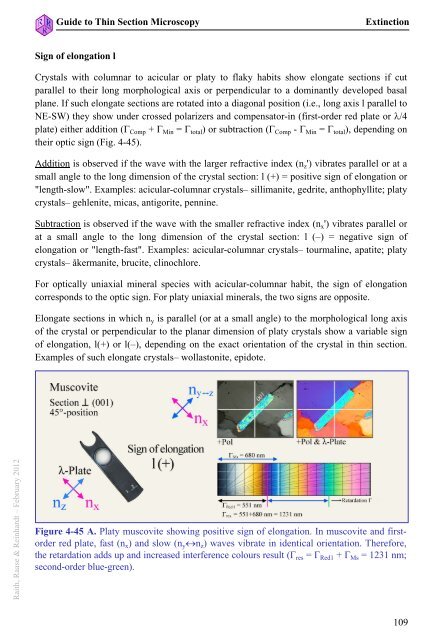guide to thin section microscopy - Mineralogical Society of America
guide to thin section microscopy - Mineralogical Society of America
guide to thin section microscopy - Mineralogical Society of America
You also want an ePaper? Increase the reach of your titles
YUMPU automatically turns print PDFs into web optimized ePapers that Google loves.
Guide <strong>to</strong> Thin Section Microscopy<br />
Extinction<br />
Sign <strong>of</strong> elongation l<br />
Crystals with columnar <strong>to</strong> acicular or platy <strong>to</strong> flaky habits show elongate <strong>section</strong>s if cut<br />
parallel <strong>to</strong> their long morphological axis or perpendicular <strong>to</strong> a dominantly developed basal<br />
plane. If such elongate <strong>section</strong>s are rotated in<strong>to</strong> a diagonal position (i.e., long axis l parallel <strong>to</strong><br />
NE-SW) they show under crossed polarizers and compensa<strong>to</strong>r-in (first-order red plate or λ/4<br />
plate) either addition (Γ Comp + Γ Min = Γ <strong>to</strong>tal ) or subtraction (Γ Comp - Γ Min = Γ <strong>to</strong>tal ), depending on<br />
their optic sign (Fig. 4-45).<br />
Addition is observed if the wave with the larger refractive index (n z ') vibrates parallel or at a<br />
small angle <strong>to</strong> the long dimension <strong>of</strong> the crystal <strong>section</strong>: l (+) = positive sign <strong>of</strong> elongation or<br />
"length-slow". Examples: acicular-columnar crystals– sillimanite, gedrite, anthophyllite; platy<br />
crystals– gehlenite, micas, antigorite, pennine.<br />
Subtraction is observed if the wave with the smaller refractive index (n x ') vibrates parallel or<br />
at a small angle <strong>to</strong> the long dimension <strong>of</strong> the crystal <strong>section</strong>: l (–) = negative sign <strong>of</strong><br />
elongation or "length-fast". Examples: acicular-columnar crystals– <strong>to</strong>urmaline, apatite; platy<br />
crystals– åkermanite, brucite, clinochlore.<br />
For optically uniaxial mineral species with acicular-columnar habit, the sign <strong>of</strong> elongation<br />
corresponds <strong>to</strong> the optic sign. For platy uniaxial minerals, the two signs are opposite.<br />
Elongate <strong>section</strong>s in which n y is parallel (or at a small angle) <strong>to</strong> the morphological long axis<br />
<strong>of</strong> the crystal or perpendicular <strong>to</strong> the planar dimension <strong>of</strong> platy crystals show a variable sign<br />
<strong>of</strong> elongation, l(+) or l(–), depending on the exact orientation <strong>of</strong> the crystal in <strong>thin</strong> <strong>section</strong>.<br />
Examples <strong>of</strong> such elongate crystals– wollas<strong>to</strong>nite, epidote.<br />
Raith, Raase & Reinhardt – February 2012<br />
Figure 4-45 A. Platy muscovite showing positive sign <strong>of</strong> elongation. In muscovite and firs<strong>to</strong>rder<br />
red plate, fast (n x ) and slow (n y ↔n z ) waves vibrate in identical orientation. Therefore,<br />
the retardation adds up and increased interference colours result (Γ res = Γ Red1 + Γ Ms = 1231 nm;<br />
second-order blue-green).<br />
109
















